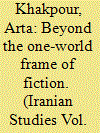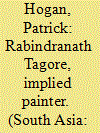| Srl | Item |
| 1 |
ID:
144723


|
|
|
|
|
| Summary/Abstract |
The debate over political commitment in Iran was never limited to adjudicating content: it was frequently a debate over form as well. In the realm of fiction, this debate fixated on realism, the nature of mimesis, and the autonomy of art and the literary text. Within a few short years after forming the iconoclastic journal Jong-e Esfahan in 1965 with a group of likeminded colleagues, the writer Hushang Golshiri had become the preeminent modernist fiction writer in Iran. His critical essays represented a passionate defense of aesthetic autonomy at a time when realism and, particularly, socialist and “engaged” literature were powerful shibboleths in the Tehran literary scene. This paper begins with a look at Golshiri's critical interventions in this debate and then moves on to show how the short stories he produced in the Jong era were an even more integral part of his response to the mimesis question. By reading his stories with a methodology drawn from “possible worlds” theories of narratology, Todorov's fantastic, and Golshiri's own theories, we see how these works break down the “one-world” frame of reality that realism takes for granted, and require the reader to grapple with multiple, often contradictory, possible realities in its stead.
|
|
|
|
|
|
|
|
|
|
|
|
|
|
|
|
| 2 |
ID:
110860


|
|
|
|
|
| Publication |
2012.
|
| Summary/Abstract |
This essay examines the idea of implied authorship in relation to painting. It considers a painting by Tagore, arguing that enigmas in the painting may be partially resolved by reference to ideas from a range of Tagore's works. This suggests that, beyond the implied author of a particular work, we should consider the implied author across a canon of works. This canonical implied author does not substitute for the implied author of an individual work. However, it provides one important context for interpretation. Moreover, it does not render the work unequivocal, but alters the profile of ambiguity of the work.
|
|
|
|
|
|
|
|
|
|
|
|
|
|
|
|